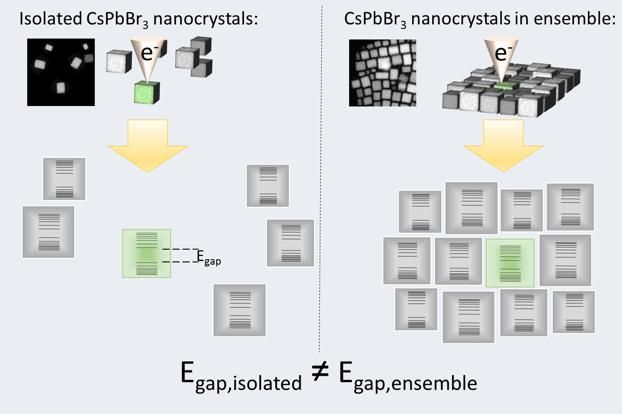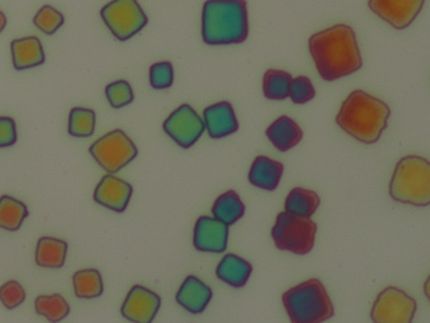Direct determination of bandgap energy of nanocrystals
An international research group led by Tom Gregorkiewicz, professor at the University of Amsterdam and Yasufumi Fujiwara, professor at Osaka University's Graduate School of Engineering together with his Japanese group at National Institute of Advanced Industrial Science and Technology determined directly the relation between the bandgap energy of single cesium lead bromide nanocrystals (CsPbBr3 NCs) and their size and shape. By studying individual NCs being either isolated or surrounded by 'neighbors', they explicitly visualized for the first time band structure modification introduced by effective coupling between semiconductor NCs upon close contact.

(Left) A completely isolated NC is studied using an electron beam (EELS), to determine its bandgap energy. (Right) A NC of the same size surrounded by neighbors is similarly probed, for which the measured bandgap energy is different. Hence, there must be a coupling between adjacent NCs in order for them to 'average' their bandgap energies.
University of Amsterdam, National Institute of Advanced Industrial Science and Technology and Osaka University
Nanocrystals and perovskites
NCs are extremely small, about a thousand times smaller than the width of a human hair. Due to their small size, the energy structure of the crystals is dramatically different from that of bulk material. In fact, the bandgap energy depends on the NC size.
The term 'perovskites' refers to the class of materials with a crystal structure in the form ABX3, and are named after the Russian mineralogist Lev Perovski. Recently, perovskites attract much attention due to their potential for high-efficient and low-cost photovoltaics. In CsPbBr3 NCs, the advantages of perovskites and NCs are combined, and they are therefore a promising material for various optoelectronic applications.
The experimental setup
The state-of-the-art technique the researchers employed, is called low-loss electron energy loss spectroscopy (EELS) and arises from low energy excitations i.e. valence electrons. It is therefore an analogy to absorption spectroscopy. Using EELS together with a scanning electron transmission (STEM) microscope with ultrahigh special resolution, allows the researchers to measure the NC dimensions and location with uniquely high precision, in parallel. In that way, the energy absorption is directly mapped onto individual NCs that are either embedded in an ensemble (they have neighbors) or are completely isolated. In that way, an intimate relation between the NC size, shape and energy bandgap is established.
Interaction and coupling between proximal nanocrystals
By determining the energy bandgap of many individual nanocrystals as a function of their size, the researchers have found that small isolated NCs appear to have a higher bandgap energy as compared to a NC of the same size surrounded by neighbors. And reversely, a large NC has lower bandgap energy if isolated than when embedded in an ensemble. Their result shows that two adjacent NCs do not simply 'merge' upon interaction and pose as a larger crystal, but rather 'average' their bandgaps. This provides direct evidence of an effective coupling between NCs where their energy bandgap and therefore energy structure, is influenced by the neighbors. These unique insights in the interacting behavior of neighboring NCs paves the way towards purposeful designing of large quantum structures and quantum-dot-solids, consisting of NCs with selective properties serving as building blocks.
Original publication
Other news from the department science

Get the chemical industry in your inbox
By submitting this form you agree that LUMITOS AG will send you the newsletter(s) selected above by email. Your data will not be passed on to third parties. Your data will be stored and processed in accordance with our data protection regulations. LUMITOS may contact you by email for the purpose of advertising or market and opinion surveys. You can revoke your consent at any time without giving reasons to LUMITOS AG, Ernst-Augustin-Str. 2, 12489 Berlin, Germany or by e-mail at revoke@lumitos.com with effect for the future. In addition, each email contains a link to unsubscribe from the corresponding newsletter.

























































